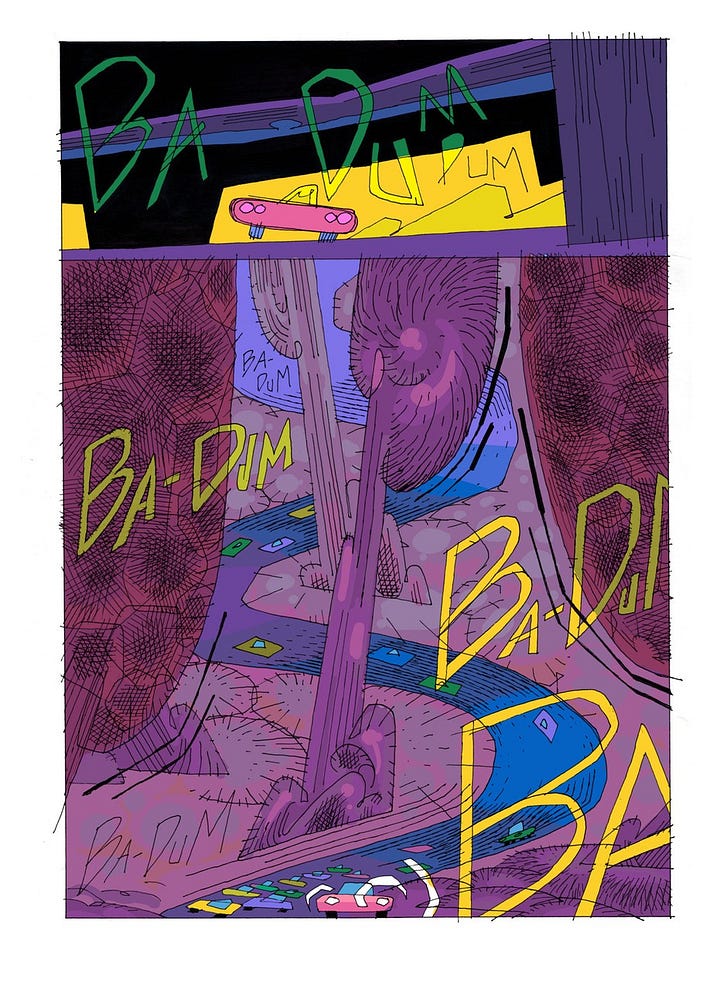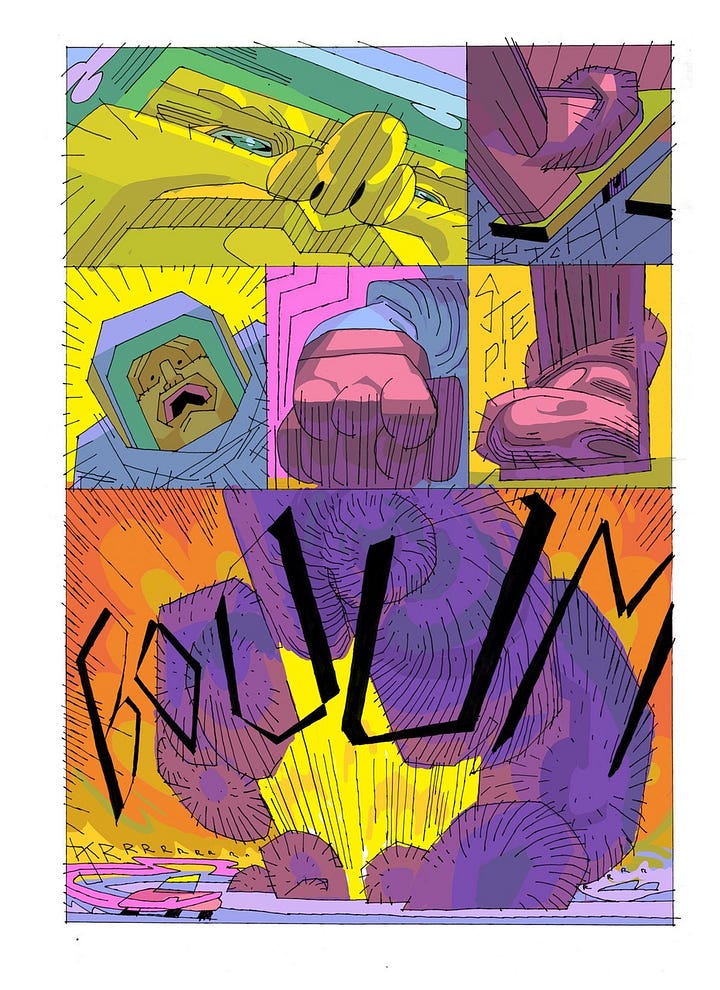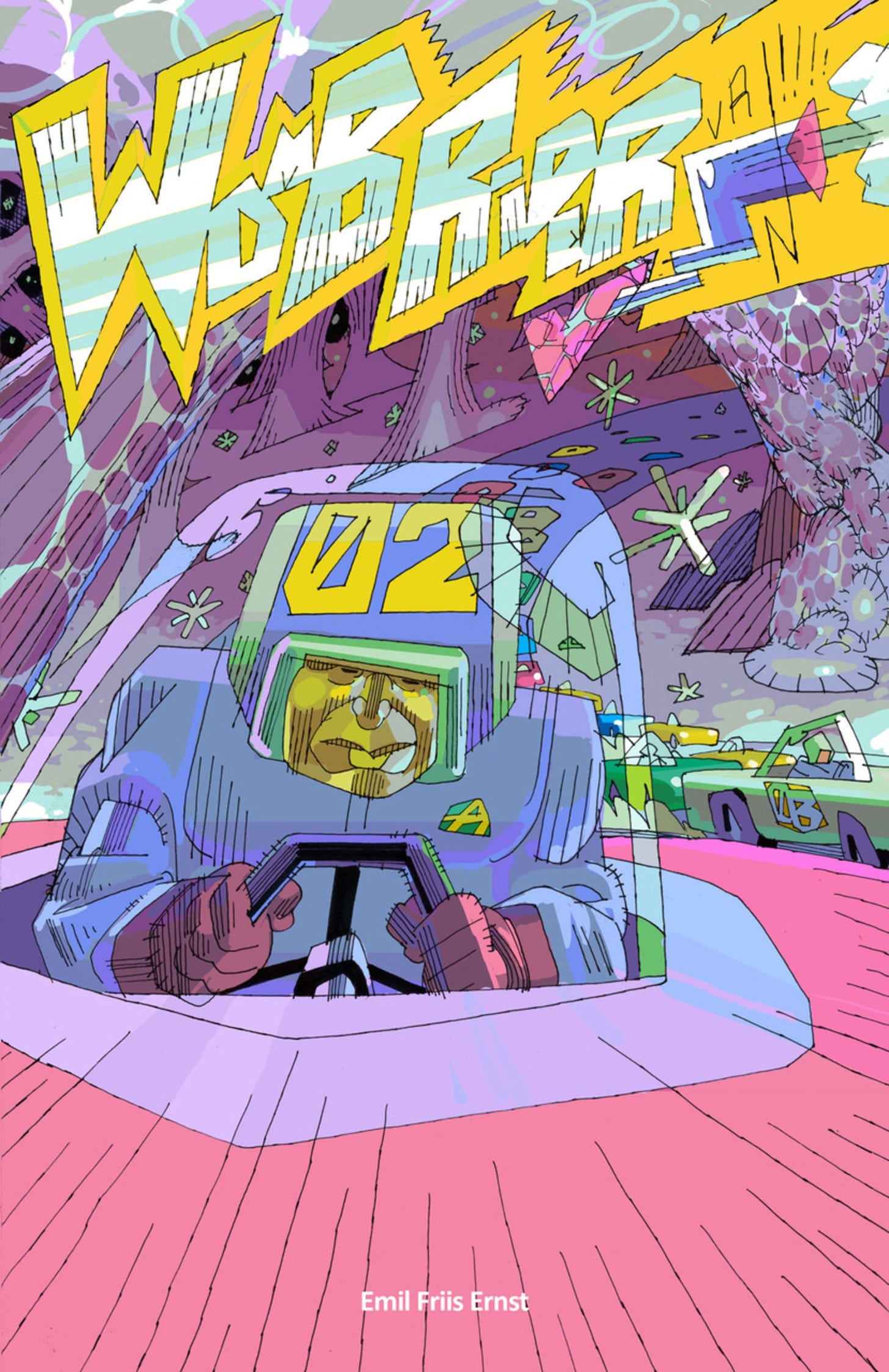Womb Rider is velocity incarnate, catch up
Every panel is Emil Friis Ernst setting the page on fire like it's going to be their last.
Required Reading is DoomRocket's love chest, opened once a month to champion a book that we adore and you should read. The latest: Emil Friis Ernst's Womb Rider, available now from Uncivilized Books.
Jaw clenched, the driver attempts to break the standing speed record. It's not the destination, it's the drift. The distance the wheels come off the road, into the air. I'd call it a foot-glued-to-the-floor kind of comic, but the truth is Womb Rider drives manual and not automatic. Every moment, every panel, is Emil Friis Ernst setting the page on fire like it's going to be their last.
What's it about? BRAAAAA VRRRRR KRSSS CH-KRK BRRRRRRR ZOOOOOOMMM TONK TAK TAK BA-BOOM — absolute visual chaos. I see it distilled in Ernst's tail light trails, maybe just because they're something I can visually hang on to in the psychedelic speed tumult. Among the copious movement lines are interlinked bubble blocks of rectangular color: the little red lamps that leave twin tracks of light behind like tire treads, paths that lead to cars going so fast they're already on the other side of the panel. Think Katsuhiro Otomo bike chase. Think Keith Giffen Trencher.
The other unlikely source of clarity is the sound effects, written large, stylized, chaotic, and free. On every page, in nearly every panel, a John Workman on mescaline atmosphere. Lettering becomes layout, with the art a supplement to the emotional size of the sound. Womb Rider is consumed with how fast feels.
Ernst's art is super abstract and yet very straightforward, intellectually evocative fuel for the imagination. A twist of the wrist against the steering wheel's resistance and the whole car skids sideways across the road, while still hurling itself forward as fast as a mortar shell shot from a cannon. Womb Rider captures each action beat.
All this metaphorical expression of movement at dangerous speeds, but it isn't depicting racing in the abstract at all. Each moment is clearly defined. The experimental aspect is Ernst visually representing how each moment feels. What makes speed communicate in a static image. It won't rely on the gutter between panels to make fast work; it strives always to show you the now.
A storm of shapes — no curves — line segments in a way that evokes Simon Gane's Paris (or Punk Strips). It's kaleidoscopic, though not like people usually mean. The jewel tone colors of Womb Rider are vivid that way. A Tidely-Idley array as indisputably perfect as they are inexplicably, chaotically juicy. Big night clouds soaking up the sherbet fire of desert sunset.
But really what I mean is, when you turn one, you become aware of the shifting contours of the mirror's edge, a structure that disappears from view when the motion stops but still keeps everything in place. Everything in Rider is drawn with the same, whisper-thin line, but Ernst knows the difference and builds upon it accordingly.
Contour lines versus texture hatching is mostly a matter of size, reinforced by the comic's colors. The hatching is dense, intense, showing the concentrated strain of internal combustion, a Bill Plympton quality of apple-cheeked, broadly toothy, highly worked detail. But then nearly every panel is fettereed with speed lines, too. Big ones, all around, distinctly not texture, the simulation of motion. The art has room to pull this off in its Uncivilized Books printing.
Ernst is a naturalist artist — stay with me here — in that the non-diegetic comic conventions don't make the storytelling feel fabricated. Covering the page in speed lines is what the story needs to read right. When comparing to Workman, the metaphor is lettering juxtaposition, but I would imagine for Ernst it's as conceptually integrated as the motion emanata and hatching textures. The lettering is the art. The swalloops are the art. The superflat but infinitely deep coming together of objects and movement is the essence of the art — the cartoonist's eye realized.


Emil Friis Ernst has a style that defies dimensions. Complicated with details to the brink of overwhelming, and yet every depiction of an actual automobile is the polar opposite of photorealistic. Sometimes a car is a square in a square. And it works! "Visually compelling" is the name of the game here: deconstructing complex machines into simple shapes makes for better panels to show you how it's supposed to feel. You know what it looks like. Nobody's going to hold your hand.
Can't read what the driver is going through from the expression on their face, though we are shown it over and over again throughout the read. But the reader already knows how it feels; the whole comic is making us feel the drive rather than just observe it. Maybe it's to remind us that he's the one going through it. The driver pulls ahead, splitting from the pack. And the light comes in, and everything goes white. All the moments and memories that make up a life — the driver's — become a halo of fractured facets that the car busts through. VRRRR
I don't need the name of the dog, the model of the car, the backstory to the first time they whatevered. What happens in Womb Rider already matters to me. It goes without saying. We're already sharing the driver's seat. I'm not concerned with lore, the metaphor, the score. Like the driver, I desire to be free from everything beyond the raw experience of the moment. Ernst artfully obliges.
Womb Rider is available now. For ordering info, click this.
Uncivilized Books / $12
Written and illustrated by Emil Friis Ernst.




